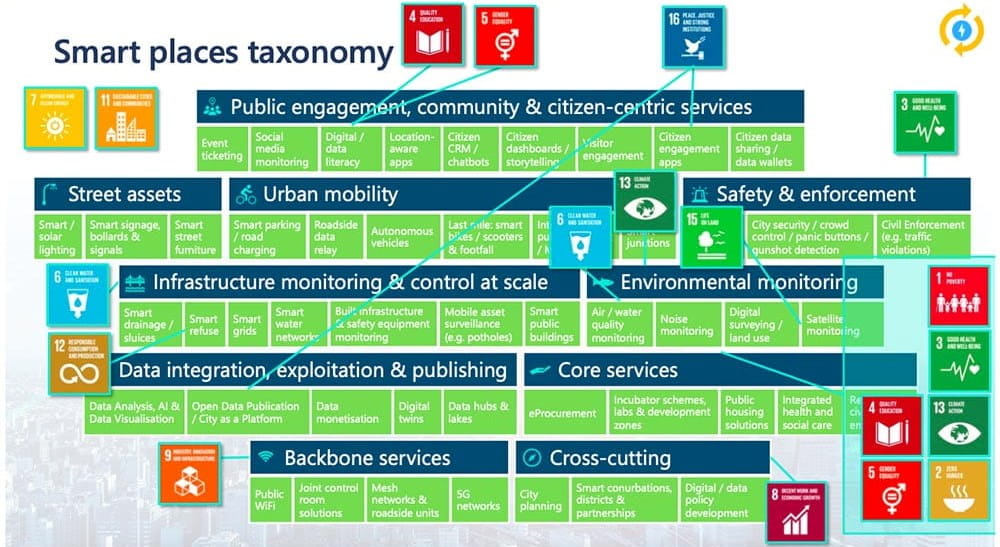Urgent action is required to mitigate the climate crisis our planet is currently facing. As Bill Gates argues, innovation can take us a long way, but it’s just not happening fast enough. Governments – from local and regional to national and supra-national – all have a role to play in facilitating the kind of innovation that will help us meet our climate goals. Places and spaces, from buildings to cities, are ripe for the deployment of such technology to improve their sustainability.
Microsoft recently invited me to speak about sustainability and smart places at its Cloud Immersion Week, alongside Linda Chandler, Microsoft's Lead for UK Smart Places. In this blog, I’ll share an overview of some of the key take away points from my talk, including the foundational role of carbon measurement technology and the importance of local and regional action to improve sustainability.
What is sustainability?
Sustainability is about meeting present needs without compromising the ability to meet the needs of future generations. We can think about sustainability with reference to three central themes: planet, people and prosperity. These three ‘Ps’ are woven into our response to the climate emergency today. They are at the heart of the UN's Sustainable Development Goals (SDGs) – a set of global goals designed to achieve a more sustainable future for all.
Sustainable Development Goals: Innovation and tech
The 17 SDGs were created with the idea that global prosperity is only sustainable if it also addresses climate change, lifts people out of poverty, preserves wildlife habitats promotes diversity and addresses other global challenges.
When it comes to technology and smart places, we can map out how certain initiatives and innovations correspond to each sustainable development goal: I call this my Smart Places taxonomy. It can be used to identify which technologies can help us move towards a specific UN goal.

For example, upgrading our core digital infrastructure maps onto Goal 9, which focuses on building resilient infrastructure and promoting sustainable industrialisation. Deploying technology to reduce road traffic accidents and deaths corresponds to Goal 3, which advocates for good health and wellbeing. Thinking in these terms helps us to keep in mind our sustainable end-goals as we deploy smart places technology.
Smart cities and buildings
Urban areas are large contributors to climate change, with cities estimated to be responsible for 75% of CO2 emissions. We need to be designing and managing our cities and buildings in a way that limits the negative impact they have on the environment. Smart technology has the potential to transform urban spaces so that sustainability considerations are built in.
NTT DATA’s SMART management platform shares insights and predictions generated from sensors and cameras, coupled with leading edge AI, to makes places ‘smart’. Its use cases range from crossing safety and urban mobility through to infrastructure monitoring and air quality. The creation of a closed-loop feedback system enables real-time feedback to prompt action on the ground. For example, undesirable patterns of pedestrian behaviour in a public space might trigger pre-recorded announcements to address that behaviour.
NTT DATA has deployed SMART camera technology in Las Vegas to reduce road traffic accidents. Cameras identify the motion paths of pedestrians and vehicles, enabling interventions that result in a 50% reduction in contra-flow related accidents. In Victoria, Australia, a different SMART solution has been used to assess occupancy on public transport, providing information on overcrowding and under-utilisation so that city planners can improve the efficiency of services.
Solutions can also be applied to buildings. Government buildings account for 2% of the UK’s emissions. Smart monitoring of occupancy in these buildings would allow for more energy efficient decisions to be made about heating, lighting and cleaning. We’ve seen this in action; NTT DATA has worked on social housing projects in Europe where the introduction of smart building management systems reduced energy demand by 75%.
Regional and local action
Climate change may be a global issue, but action is needed at local and regional level to bring us within sight of our climate goals. Local action is important because each locality has specific needs. A port city has different needs to a land-locked one, for example. In Liverpool, huge quantities of emissions are produced by ships in dock, so a local solution might include the provision of shore-side renewable electricity for ships to run their generators.
The different approaches adopted by devolved powers across localities can drive healthy competition to reach net-zero targets. Glasgow has previously stated its ambition to become the UK’s first carbon neutral city by 2030, competing with Edinburgh to meet that goal. People are also more likely to be engaged and invested in change happening in their own locality in contrast to overarching national policies. We see this with congestion charges, which are generally unpopular but often welcomed at a local level when people can see the direct benefits such as cleaner air.
Whichever solutions localities choose to implement, measurement is a first and crucial step. At NTT DATA, our Single View of Carbon – an end-to-end carbon footprint calculation and reporting platform – allows organisations to visualise their carbon emissions. There are challenges involved in this type of measurement, especially when we consider emissions from the wider supply chain, but working towards a better understanding of the size and nature of the problem enables the most effective solutions to be implemented.